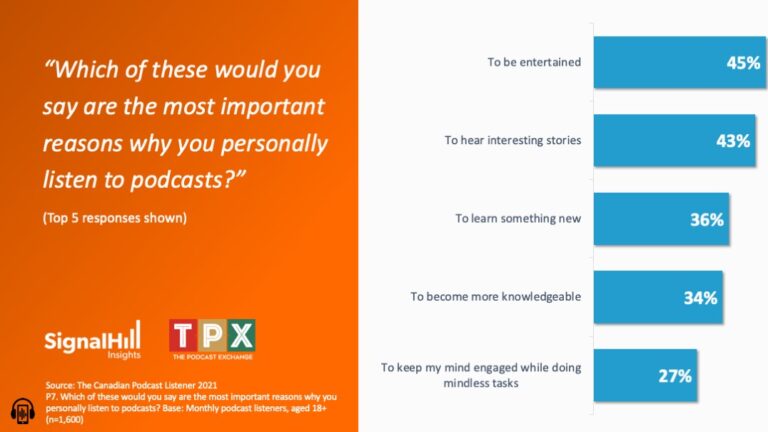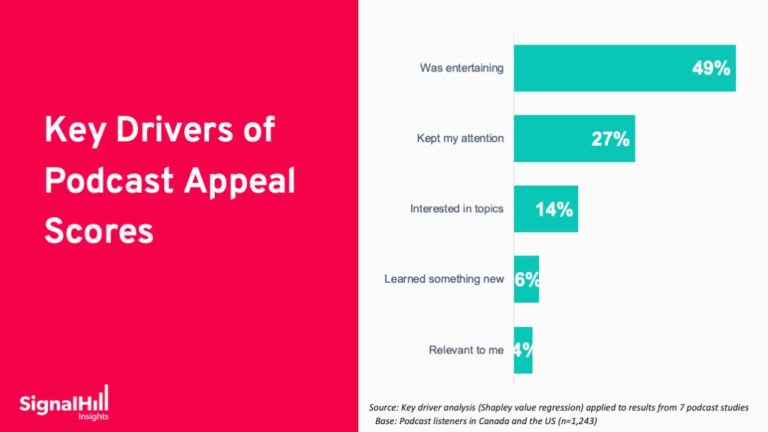Whether you agree that podcasts have a ‘discovery problem’ or not, there’s no doubt that the big players in the space are spending a lot of time, money and inventory to promote their shows and stand out from the (literally) millions of competing podcasts out there.
The truth of the matter is all the promotion in the world can only get your podcast a single download from any given listener. Every subsequent download is going to be based on whether the podcast delivers value to listeners, keeping them coming back episode-after-episode.
Essentially, every incremental download past the first is improving the ROI on the marketing cost of reaching that listener, so every effort should be made to make sure that every listener who tries your podcast is a repeat listener.
Even if you have an amazing show, there are a LOT of podcasts out there. If only one of every hundred podcasts is in that top tier of amazing, you’re still competing with tens of thousands of podcasts.
Check the math. Even the most die-hard podcast listener cannot listen to every episode that gets released. In fact, a growing number of listeners can’t find the time for all of their favourite podcasts without cranking up the speed. Eventually, listeners drinking from the audio firehose start deciding which podcasts just aren’t going to stay in rotation.
Which brings us to the fundamental question of this article:
What are the determining factors on whether a podcast will make the cut? (Or what are the key drivers to podcast appeal?)
Luckily, the podcast studies we’ve conducted at Signal Hill Insights, each representing a diversity of listeners, have resulted in a robust set of data to draw answers from…
So what are we working with?
Since each study is designed with a client’s specific goals in mind, not all of the questions we ask in our podcast studies are relevant beyond the show or brand being measured, but we do have a set of standard benchmark questions that are asked in nearly every case. The most basic of these is appeal – how much the listener liked the podcast. We also like to get a sense of how the listeners feel about each podcast on various diagnostic measures – the podcast’s relevance to them, how interested they were in the topic, whether it was entertaining, whether they learned something new from the podcast and whether or not it kept their attention.
While these are not the only factors that could play into the appeal of a given podcast, they are broadly applicable to most podcasts, and reflect some of the top reasons for listening to podcasts that were identified in our most recent The Canadian Podcast Listener study.

How it was studied
For the research methodology enthusiasts in the house, here’s how we analyzed the data: After doing a simple correlation check to confirm that there was at least some relationship between the diagnostic measures and podcast appeal, a more in-depth analysis was run using nearly 1,300 listener responses to seven podcasts of different formats/genres. A key driver analysis (using Shapley Value Regression) was done to determine the relative importance of each of the diagnostic elements in driving the appeal scores.
What we found
Entertainment wins all.
While we expected entertainment value to be a strong driver of podcast appeal, we were a little surprised to see how dominant it was at determining whether or not a listener liked the podcast, being nearly equal in importance to all other factors combined.
The relatively low impact of relevance makes sense in the context of how our survey samples are collected. So that our studies represent listeners who would be likely to choose the podcast ‘in the wild,’ we screen listeners based on their existing listening habits, meaning that there shouldn’t really be anyone in the sample for whom the podcast was completely irrelevant.

What does this mean for podcast producers?
Entertainment value should be your first and foremost consideration when making a podcast, whether it’s a scripted drama, branded podcast or educational how-to show.
Podcasts are still entertainment media, and while more than a third of listeners in The Canadian Podcast Listener 2021 said that they listen to podcasts to learn something new, the driver analysis shows that without entertainment value, teaching listeners something new is not going to be enough on its own.
If someone just wants to learn how to code in Python, knit a sweater, or create a balanced investment portfolio, there are plenty of ways to get this information more efficiently than through a podcast. Podcasts are bringing something to the table beyond just information.
An example of this is the “Love to Sew” podcast. Canadian hosts Helen Wilkinson and Caroline Somo welcome listeners of all levels to the world of sewing, making them fall in love with the hobby and teaching them something new in every episode.
Podcasts that keep listeners coming back weave information with authenticity, intimacy, engaging narratives and intentional sound design to set themselves apart from a purely functional experience.
A Final Word
By all means, set aside an ample marketing budget for your podcast, but if you think that any one of those marketing dollars could be used to make your podcast more entertaining, you may find that investing in the product makes your marketing campaigns more fruitful in the long run.
Signal Hill Insights is an audio research consultancy helping publishers, broadcasters and advertisers tap new opportunities in audio. As part of our services, we help our clients optimize the appeal of their podcasts. For more information, please contact us here.




